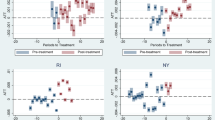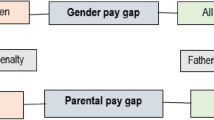Abstract
We estimate how parenthood affects hourly wages using panel data for Norwegian employees in the years 1997–2007. Though smaller than for most other OECD countries, we find substantial wage penalties to motherhood, ranging from a 1.2 % wage reduction for women with lower secondary education to 4.9 % for women with more than four years of higher education. Human capital measures such as work experience and paid parental leave do not explain the wage penalties, indicating that in the Norwegian institutional context, mothers are protected from adverse wage effects due to career breaks. We do however find large heterogeneity in the effects, with the largest penalties for mothers working full time and in the private sector. Contrary to most studies using US data and to previous research from Norway, we find a small wage penalty also to fatherhood. Also for men, the penalty is greater for those who work full time and in the private sector. A substantial share of the fatherhood wage penalty is explained by paternity leave.
Similar content being viewed by others
Notes
Unless tied specifically to institutional or biological gender differences, these explanations would also apply to fatherhood wage penalties.
Mothers being expected by employers to take leave for a considerable period of time means maternity leave is not a strong signal to the employer of their type. For men, on the other hand, the length of parental leave is a strong signal of how much effort they will spend at work.
However, Wilde et al. (2010) argue that if parenthood affects both wage levels and wage growth, the effect of reduced effort during early years may have a lasting effect. If the wage trajectory changes growth rate, the difference between parents and childless individuals may even be increasing, a pattern found in Wilde et al. (2010) on US data. A long term persistence in motherhood wage effects is found in several other studies, like Viitanen (2014) using UK data.
Our division—further described in Sect. 3—is similar to one in Anderson et al. (2003), but we have a separate group with a master degree or higher. This is a small group, but interesting because of the large career potential, meaning motherhood may be a substantial hinder as is shown in e.g. Bertrand et al. (2010). The timing of the first child is clearly different between education groups: Age at first birth increases by one year on average between one educational group and the next.
The fourth order polynomial is chosen in order to be as flexible as possible, given that the use of age dummies is not feasible due to multicollinearity with year and individual fixed effects.
Results are therefore representative of employees only. The share of self-employed in the labor force is about 4 % for women and almost 10 % for men during the period under study, with smaller shares for individuals with small children (Villund 2005).
Using other official registries we find that about 20 % of women and 7 % of men who have a missing wage observation when their first child is 3 years old have earnings below the basic amount (G) of the Norwegian social security system, meaning that they are marginally or not employed at all that year (from January 1 2010, G is NOK 72 881, approximately USD 12 500). About 50 % of the women and 75 % of the men with missing wage observations are registered as employed. Some of the remaining missing observations may indicate self-employment.
When the timing of children differs between educational groups, the estimate for the full sample will typically be different from the average over the within-group estimates. Estimating the effect of children relative to the counterfactual wage path for the full sample means individuals in the highest education group are over-represented among the (still) childless, while individuals in the lower education group are over-represented among those who have already had children. The same pattern is found in Anderson et al. (2002).
For comparison, the average return to one more year of education for women in Norway in this period, lies between 5 and 6 % (Hægeland and Kirkebøen 2007, p.14) and the gender wage gap in Norway lies around 16 % (NOU 2008:6).
Results are available from the authors upon request.
Results are available from the authors upon request.
The positive effects of job protection on mothers’ wages may explain parts of the differences in the size of motherhood wage penalties across countries (Sanchez-Marcos 2013).
If part time work is chosen by women because they anticipate childbearing, the wage penalty may have been realized even before the child is born, and will not be picked up by our estimates.
Results are available from the authors upon request.
References
Adda, J., Dustmann, C., & Stevens, K. (2011). The career costs of children. Working paper.
Albrecht, J. W., Edin, P.-A., Sundstrøm, M., & Vroman, S. B. (1999). Career interruptions and subsequent earnings: A reexamination using Swedish data. Journal of Human Resources, 34(2), 294–311.
Anderson, D. J., Binder, M., & Krause, K. (2002). The motherhood wage penalty: Which mothers pay it and why? American Economic Review, 92(2), 354–358.
Anderson, D. J., Binder, M., & Krause, K. (2003). The motherhood wage penalty revisited: Experience, heterogeneity, work effort, and work-schedule flexibility. Industrial and Labor Relations Review, 56(2), 273–294.
Angrist, J. D., & Evans, W. N. (1998). Children and their parents’ labor supply: Evidence from exogenous variation in family size. American Economic Review, 88(3), 450–77.
Antonovics, K., & Town, R. (2004). Are all the good men married? Uncovering the sources of the marital wage premium. American Economic Review, 94(2), 317–321.
Astone, N., Dariotis, J., Sonenstein, F., Pleck, J., & Hynes, K. (2010). Men’s work efforts and the transition to fatherhood. Journal of Family and Economic Issues, 31(1), 3–13.
Becker, G. S. (1985). Human capital, effort, and the sexual division of labor. Journal of Labor Economics, 3(1), S33–58.
Bertrand, M., Goldin, C., & Katz, L. F. (2010). Dynamics of the gender gap for young professionals in the financial and corporate sectors. American Economic Journal: Applied Economics, 2, 228–255.
Buckles, K. (2008). Understanding the returns to delayed childbearing for working women. The American Economic Review, 98(2), 403–407.
Budig, M. J., & England, P. (2001). The wage penalty for motherhood. American Sociological Review, 66(2), 204–225.
Cools, S., & Strøm, M. (2012). The effect of children on labor supply and wage elasticities in the household. Working paper.
Coverman, S. (1983). Gender, domestic labor time, and wage inequality. American Sociological Review, 48(5), 623–637.
Datta Gupta, N., & Smith, N. (2002). Children and career interruptions: The family gap in Denmark. Economica, 69(276), 609–29.
Harkness, S., & Waldfogel, J. (2003a). The family gap in pay: Evidence from seven industrialized countries. In Research in Labor Economics, 22, 369–414.
Harkness, S., & Waldfogel, J. (2003b). The family gap in pay: Evidence from seven industrialized countries, volume 22 of worker well-being and public policy (Research in Labour Economics), pp. 369–413. Emerald Group Publishing Limited.
Hersch, J., & Stratton, L. S. (1997). Housework, fixed effects, and wages of married workers. Journal of Human Resources, 32(2), 285–307.
Hægeland, T., & Kirkebøen, L. J. (2007). Lønnsforskjeller mellom utdanningsgrupper. SSB Notater 36.
Hofferth, S. L. (1984). Long-term economic consequences for women of delayed childbearing and reduced family size. Demography, 21(2), 141–155.
Korenman, S., & Neumark, D. (1991). Does marriage really make men more productive? The Journal of Human Resources, 26(2), 282–307.
Korenman, S., & Neumark, D. (1992). Marriage, motherhood, and wages. Journal of Human Resources, 27(2), 233–255.
Lundberg, S., & Rose, E. (2000). Parenthood and the earnings of married men and women. Labour Economics, 7(6), 689–710.
Lundberg, S., & Rose, E. (2002). The effects of sons and daughters on men’s labor supply and wages. The Review of Economics and Statistics, 84(2), 251–268.
McAllister, I. (1990). Gender and the household division of labor. Work and Occupations, 17(1), 79–99.
Miller, A. (2011). The effects of motherhood timing on career path. Journal of Population Economics, 24(3), 1071–1100.
Millimet, D. L. (2000). The impact of children on wages, job tenure, and the division of household labour. The Economic Journal, 110(462), C139–C157.
Mincer, J., & Polachek, S. (1974). Family investment in human capital: Earnings of women. Journal of Political Economy, 82(2), S76–S108.
Nielsen, H. S., Simonsen, M., & Verner, M. (2004). Does the gap in family-friendly policies drive the family gap? Scandinavian Journal of Economics, 106(4), 721–744.
Rosenzweig, M. R., & Wolpin, K. I. (1980). Life-cycle labor supply and fertility: Causal inferences from household models. Journal of Political Economy, 88(2), 328–348.
Sanchez-Marcos, V. (2013). Female labour market outcomes and parental leave policies. Working paper.
Shelton, B. A., & Firestone, J. (1989). Household labor time and the gender gap in earnings. Gender and Society, 3(1), 105–112.
Simonsen, M., & Skipper, L. (2008). An empirical assesment of effects of parenthood on wages. Advances in Econometrics, 21, 359–380.
Taniguchi, H. (1999). The timing of childbearing and women’s wages. Journal of Marriage and Family, 61(4), 1008–1019.
Viitanen, T. (2014). The motherhood wage gap in the uk over the life cycle. Review of Economics of the Household (forthcoming).
Villund, O. (2005). Yrkesdata for selvstendig næringsdrivende. Dokumentasjonsnotat: Statsitics Norway (SSB). 43.
Waldfogel, J. (1997). The effect of children on women’s wages. American Sociological Review, 62(2), 209–217.
Waldfogel, J. (1998a). The family gap for young women in the united states and britain: Can maternity leave make a difference? Journal of Labor Economics, 16(3), 505–545.
Waldfogel, J. (1998b). Understanding the “family gap” in pay for women with children. The Journal of Economic Perspectives, 12(1), 137–156.
Wilde, E. T., Batchelder, L., & Ellwood, D. T. (2010). The mommy track divides: The impact of childbearing on wages of women of differing skill levels. Working paper 16582, National Bureau of Economic Research.
Author information
Authors and Affiliations
Corresponding author
Additional information
We are grateful to Jenny Clarhäll, Eva Kløve, Andreas Kotsadam, Ingrid Krüger, Jo Thori Lind, Kalle Moene and Fredrik Willumsen for helpful comments and suggestions. The authors bear all responsibility for errors and shortcomings. This paper is part of the research activities at the center of Equality, Social Organization, and Performance (ESOP) at the Department of Economics at the University of Oslo, in collaboration with the Ragnar Frisch Centre for Economic Research. We acknowledge funding from the Norwegian Research Council (Frisch project 1110). Data made available by Statistics Norway have been essential for the research project. ESOP is supported by the Research Council of Norway.
Rights and permissions
About this article
Cite this article
Cools, S., Strøm, M. Parenthood wage penalties in a double income society. Rev Econ Household 14, 391–416 (2016). https://doi.org/10.1007/s11150-014-9244-y
Received:
Accepted:
Published:
Issue Date:
DOI: https://doi.org/10.1007/s11150-014-9244-y




